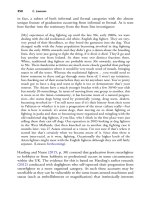The palgrave international handbook of a 35
Bạn đang xem bản rút gọn của tài liệu. Xem và tải ngay bản đầy đủ của tài liệu tại đây (26.52 KB, 1 trang )
Breeding and Selling of Companion Animals
23
under PETS from Lithuania increased by 780 % and from Hungary by
663 % between 2011 and 2013 (Dogs Trust 2014). This is evidenced by a
recent successful prosecution of two Lithuanians importing puppies from
Lithuania in 2016 for a number of offences under the Fraud, Animal Welfare
and Pet Animals Acts.
Explanation for Harmful Behaviours
This section identifies the key drivers for the harms associated with the
puppy trade. It begins by considering the attitudes, beliefs and behaviour
of the people who purchase puppies, and thereby enable the legal and illegal
trade. It then considers how this consumer behaviour can facilitate behaviours by breeders and traders, noting the drivers of those behaviours. Finally
it considers how current legislation on trade and animal movement can also
exacerbate these harmful behaviours.
Consumer Credulity
There is a huge demand for puppies, which has created a buoyant market
economy, usually focused on a number of popular breeds. Purchasers are often
strongly motivated to obtain a young puppy or kitten due to the ‘cute factor’.
Seemingly as a result, many breeds are bred to have large heads and eyes,
intensifying cuteness—although these features can also increase the risks of
some harms, such as brain problems in King Charles cavalier spaniels and eyes
‘popping out’ in breeds with very prominent eyes. Puppies and kittens are,
therefore, at their most marketable at a very young age (between 6 and 16
weeks). Many people specifically want a purebred dog. Some consumers may
still have the Victorian mindset that ‘purebred’ or ‘pedigree’ confer a mark of
quality (whereas, in fact, at best, these descriptions are a mark of predictability
—which includes predictable breed-specific diseases and inherited disorders).
Some purchasers may also perceive an elevated status to be associated with
pedigree ownership, either because purebreds may be more expensive than
crossbred dogs, or because certain breeds confer a desirable social status.
More specifically, demand is often focused on certain breeds, as potential
puppy owners usually want a certain breed or type of dog. The motivation
for these breed choices may be dictated by:
– Personal experiences. Some owners have previously owned such a breed
and want a ‘replacement’, anticipating that the new dog will be like the









